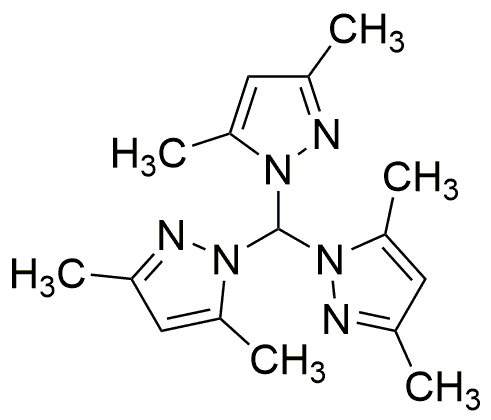Tris(3,5-dimethyl-1-pyrazolyl)methane is widely utilized in research focused on:
- Catalysis: This compound serves as an effective ligand in various catalytic processes, enhancing reaction rates and selectivity in organic synthesis.
- Coordination Chemistry: It is used to form stable metal complexes, which are essential in developing new materials and studying metal ion behavior in different environments.
- Analytical Chemistry: The compound acts as a reagent in analytical methods, helping to detect and quantify metal ions in environmental and biological samples.
- Pharmaceutical Development: Its unique properties make it a candidate for drug formulation, particularly in creating targeted delivery systems for therapeutic agents.
- Material Science: It plays a role in synthesizing advanced materials, such as polymers and nanocomposites, which have applications in electronics and coatings.
General Information
Properties
Safety and Regulations
Applications
Tris(3,5-dimethyl-1-pyrazolyl)methane is widely utilized in research focused on:
- Catalysis: This compound serves as an effective ligand in various catalytic processes, enhancing reaction rates and selectivity in organic synthesis.
- Coordination Chemistry: It is used to form stable metal complexes, which are essential in developing new materials and studying metal ion behavior in different environments.
- Analytical Chemistry: The compound acts as a reagent in analytical methods, helping to detect and quantify metal ions in environmental and biological samples.
- Pharmaceutical Development: Its unique properties make it a candidate for drug formulation, particularly in creating targeted delivery systems for therapeutic agents.
- Material Science: It plays a role in synthesizing advanced materials, such as polymers and nanocomposites, which have applications in electronics and coatings.
Documents
Safety Data Sheets (SDS)
The SDS provides comprehensive safety information on handling, storage, and disposal of the product.
Product Specification (PS)
The PS provides a comprehensive breakdown of the product’s properties, including chemical composition, physical state, purity, and storage requirements. It also details acceptable quality ranges and the product's intended applications.
Certificates of Analysis (COA)
Search for Certificates of Analysis (COA) by entering the products Lot Number. Lot and Batch Numbers can be found on a product’s label following the words ‘Lot’ or ‘Batch’.
Numéro de catalogue
Numéro de lot/série
Certificates Of Origin (COO)
This COO confirms the country where the product was manufactured, and also details the materials and components used in it and whether it is derived from natural, synthetic, or other specific sources. This certificate may be required for customs, trade, and regulatory compliance.
Numéro de catalogue
Numéro de lot/série
Safety Data Sheets (SDS)
The SDS provides comprehensive safety information on handling, storage, and disposal of the product.
DownloadProduct Specification (PS)
The PS provides a comprehensive breakdown of the product’s properties, including chemical composition, physical state, purity, and storage requirements. It also details acceptable quality ranges and the product's intended applications.
DownloadCertificates of Analysis (COA)
Search for Certificates of Analysis (COA) by entering the products Lot Number. Lot and Batch Numbers can be found on a product’s label following the words ‘Lot’ or ‘Batch’.
Numéro de catalogue
Numéro de lot/série
Certificates Of Origin (COO)
This COO confirms the country where the product was manufactured, and also details the materials and components used in it and whether it is derived from natural, synthetic, or other specific sources. This certificate may be required for customs, trade, and regulatory compliance.


